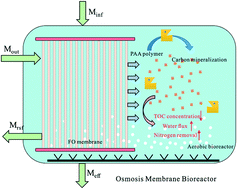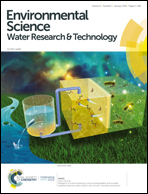Mitigation of solute buildup by using a biodegradable and reusable polyelectrolyte as a draw solute in an osmotic membrane bioreactor
Abstract
Reverse solute flux (RSF) is a key challenge for operating osmotic membrane bioreactors (OMBRs) and can severely affect the OMBR performance due to solute accumulation in the feed side. Herein, a biodegradable polyelectrolyte (polyacrylic acid sodium salt, PAA) was investigated as a draw solute (DS) for OMBR application with a focus on the mitigation of solute build-up via biodegradation of PAA. Both activated sludge and OMBR tests confirmed that PAA can be biologically degraded. In the OMBR, a residue PAA concentration of 14.1 mg L−1 was observed in the feed solution due to a dynamic balance between PAA removal/biodegradation and continuous RSF. Compared to a non-biodegradable DS (NaCl) that had a water recovery of 3.4 ± 0.1 L and a reverse solute flux (RSF) of 9.46 ± 0.21 gMH, the PAA DS achieved a higher water recovery of 17.9 ± 0.5 L over 30 days of operation (the average water flux, 4.97 ± 0.14 LMH), a much lower RSF of 0.12 ± 0.01 gMH, and a higher nitrogen removal of 58.4 ± 1.5%. The recovery and reuse of the PAA DS were investigated with a long-term operation (150 days), which demonstrated the feasibility of reusing the PAA DS, despite some decrease in water recovery and biological treatment performance. Those results have collectively demonstrated the advantages of the PAA-based draw solute for reducing reverse-fluxed solutes towards optimized OMBR operation and applications.



 Please wait while we load your content...
Please wait while we load your content...